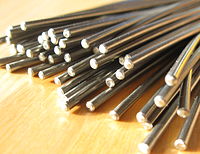
Photo from wikipedia
Abstract Microstructure is a crucial parameter to affect elastocaloric effect in the Ni–Mn-based alloys. However, the specific influence of different microstructural parameters on elastocaloric effect remains unclear. In the present… Click to show full abstract
Abstract Microstructure is a crucial parameter to affect elastocaloric effect in the Ni–Mn-based alloys. However, the specific influence of different microstructural parameters on elastocaloric effect remains unclear. In the present work, the effect and underlying mechanism of microstructure, including grain size and texture, on the martensitic transformation, mechanical properties and elastocaloric effect in Ni50Mn34.8In15.2 alloy were studied. Three fabrication techniques including the arc-melting, suction casting and directional solidification were utilized to obtain different microstructures. Results show that the phase transition temperature and transformation entropy change are insensitive to the microstructure. While, the microstructure has an obvious influence on phase transition interval ΔTInt. The suction casting sample has the widest ΔTInt. Moreover, we observed that the adiabatic temperature change ΔTad largely depended on the feature of microstructure. The grain boundary is disadvantageous to ΔTad. On the one hand, it would interact with habit plane and bring about energy consumption. On the other hand, due to the enhanced energy for full transformation, it would reduce the volume fraction of phase transition under certain external strain or force. The fracture mechanism of the Ni–Mn-based alloy is independent of microstructure, i.e. brittle fracture with intergranular pattern. It is attributed to the strong p-d covalent hybridization between Ni and main-group element (In). Strong texture and coarse grain are favorable to improve the mechanical properties. This study may provide some guidance for microstructure design to improve the elastocaloric effect for the Ni–Mn-based alloys.
Journal Title: Intermetallics
Year Published: 2019
Link to full text (if available)
Share on Social Media: Sign Up to like & get
recommendations!